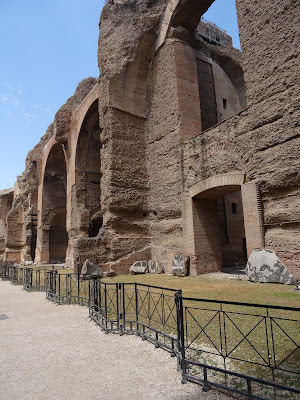The Circus Maximus (Latin for greatest or largest circus, in
Italian Circo Massimo) is an ancient Roman chariot racing stadium and mass
entertainment venue located in Rome, Italy. Situated in the valley between the
Aventine and Palatine hills, it was the first and largest stadium in ancient
Rome and its later Empire. It measured 621 m (2,037 ft) in length and 118 m
(387 ft) in width and could accommodate over 150,000 spectators. In its fully
developed form, it became the model for circuses throughout the Roman Empire.
The site is now a public park. The Circus was Rome's largest venue for ludi,
public games connected to Roman religious festivals. Ludi were sponsored by
leading Romans or the Roman state for the benefit of the Roman people (populus
Romanus) and gods.
The Orange Garden (Italian: Giardino degli Aranci) is the name
used in Rome to describe the Savello park (Parco Savello). It is about 7,800
square meters and is located on the Aventine Hill. The park offers an excellent
view of the city. The garden, as it is today, was designed in 1932 by Raffaele
De Vico. [1]It was constructed to offer public access to the view from the side
of the hill, creating a new ‘’belvedere’’, to be added to the existing
viewpoints in Rome from the Pincian Hill and the Janiculum. The garden, whose
name comes from the many bitter orange trees growing there, extends over the
area of an ancient fortress built near the basilica of Santa Sabina by the
Savelli family between 1285 and 1287, which, in turn, was built over an old
castle constructed by the Crescentii in the tenth century. The garden is
bordered by a wall that once surrounded the Savelli castle and other remains of
the castle can also be still seen. The castle was later given to the Dominican
Order from Santa Sabina, which transformed it into a monastery, and the small
park into a vegetable garden. According to legend Saint Dominic gave the garden
its first orange tree, after transporting a sapling from Spain. Legend also
tells that Saint Catherine of Siena picked the oranges from this tree and made
candied fruit, which she gave to Pope Urban VI.
The Baths of Caracalla (Italian: Terme di Caracalla) in
Rome, Italy, were the city's second largest Roman public baths, or thermae,
likely built between AD 212 (or 211) and 216/217, during the reigns of emperors
Septimius Severus and Caracalla. They were in operation until the 530s and then
fell into disuse and ruin. However, they have served as an inspiration for many
other notable buildings, including the Baths of Diocletian, Basilica of
Maxentius, the original Pennsylvania Station (New York) and Chicago Union
Station. Art works recovered form the ruins include famous sculptures such as
the Farnese Bull and the Farnese Hercules.
Construction - 216-235: Construction of the baths was
probably initiated by emperor Septimius Severus and completed during the reign
of his son, Caracalla. They were inaugurated in AD 216. The baths were located
in the southern area of the city, Regio XII, where members of the Severan
family commissioned other construction works: the via nova leading to the baths
and the Septizodium on nearby Palatine Hill. For work to have been mostly
completed in the time of Caracalla, workers would have had to install over
2,000 t (2,000 long tons; 2,200 short tons) of material every day for six years
in order to complete it between 211 (when Severus died) and 216. Work on
additional decorations continued under Caracalla's successors Elagabalus and
Severus Alexander. The baths were likely mostly finished by 235. Later
renovations were conducted under Aurelian (after a fire) and by Diocletian.
Under Constantine the Great the caldarium was modified. The building was heated
by a hypocaust, a system of burning coal and wood underneath the ground to heat
water provided by a dedicated aqueduct. The baths were free and open to the
public.












































































Niciun comentariu:
Trimiteți un comentariu